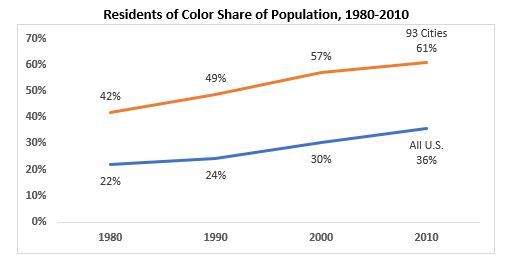Over recent decades, the share of the U.S. population that identify as non-Hispanic white has declined, from 78 percent in 1980 to 64 percent by 2010. The trend is even more pronounced in large cities1, which have both greater shares of residents of color and larger increases in those shares over time – from 42 percent in 1980 to 61 percent in 2010.

Cities are not homogeneous by race and ethnicity, however, with some neighborhoods still majority non-Hispanic white. Nor are changes within these neighborhoods consistent; for example, those that have experienced gentrification – or the in-migration of higher-income households into traditionally low-income communities – likely have different patterns of racial change than non-gentrified neighborhoods, given inequalities in income distributions across households by race and ethnicity.
Specifically, we might expect more non-Hispanic whites among the new residents of gentrifying neighborhoods than among those moving into non-gentrifying areas of cities, given their higher incomes relative to households of color. Any change in the share of residents of color in of such neighborhoods would therefore likely be smaller or even negative relative to the city overall.
Which Definition of Gentrification?
Confirming this assumption about changing racial composition in gentrified neighborhoods, however, is not so straightforward, as definitions of what constitutes gentrification vary widely with little consensus on how to measure where and when it occurs. The 2018 report, Gentrification: Framing Our Perceptions, describes some of the ways that definitions of gentrification differ, including in the identification of neighborhoods considered low-income enough to be eligible to gentrify.
The online Gentrification Comparison Tool (GCT) takes this point a step further, by recreating three popular approaches to measuring gentrification – by Freeman (2005), Ellen & O’Regan (2008), and McKinnish et al (2010) – and mapping their results over 93 cities and 40 years of tract-level data from the Decennial Census. This tool shows how the sets of neighborhoods each approach calls gentrified often have little overlap within a city and decade.
Different sets of presumed gentrified neighborhoods, moreover, will experience different consequences associated with their changing conditions. For example, a set of gentrified neighborhoods identified under one definition might show a larger change in the racial composition of its residents relative to the rest of the city, while those considered gentrified under a different approach could have the opposite trend.
Assessing Racial Change in Gentrified Neighborhoods
To test this theory, we analyzed changes in the racial composition of gentrified vs. non-gentrified neighborhoods across the three definitions detailed in the GCT. Specifically, we calculated the percentage-point difference in the share of residents who are people of color (i.e., not non-Hispanic white) in tracts aggregated by the three types of neighborhoods identified (not eligible to gentrify, eligible but not gentrified, and eligible and gentrified) under each of the operationalized definitions of gentrification.
The interactive dashboard below shows the results of this analysis by decade (1980s, 1990s, and 2000s)2for all 93 cities combined, as well as individually for a subset of 10 cities with at least five gentrified tracts under each definition in each decade.3
As noted above, the populations of the 93 cities combined increased their share of people of color substantially between 1980 and 2010, flipping from a majority to a minority of non-Hispanic white residents over this period. Toggling through the different decades in the dashboard shows that nearly all subsets of neighborhoods by gentrification status in the 93 cities also saw such increases.
However, all three definitions show smaller increases in the share of residents of color in gentrified neighborhoods, relative to both neighborhoods that are not eligible to gentrify (generally because of higher incomes at the start of the decade) and neighborhoods that were eligible but did not meet the conditions for these definitions of gentrification.
This relationship is consistent across all three decades of analysis. In the 1980s, for example, the change in the share of people of color in the 93 cities overall was 6.9 percentage points (from 41.8 percent to 48.7 percent), but in the gentrified neighborhoods identified by the three definitions was 5.6 (Freeman), 4.0 (McKinnish) and 1.9 (Ellen & O’Regan) percentage points.
The same pattern appears in the 1990s (1.9 to 4.0 percentage point change across the definitions vs. 8.3 percentage points over the 93 cities) and the 2000s, in which two of the definitions show a decline in the share of people of color in gentrified neighborhoods despite a 4.0 percentage point increase across all city neighborhoods.
We can also confirm this relationship holds within most of the 10 individual cities with sufficient numbers of gentrified tracts to analyze separately. Specifically, in 82 of the 90 possible combinations of cities (10), decades (3) and definitions (3), gentrified tracts had smaller increases or decreases in the share of people of color in gentrified tracts relative to all tracts in that city.4
These results thus suggest that, regardless of the definition of gentrification used, gentrified neighborhoods consistently had fewer people of color and/or more non-Hispanic white residents move in (and the opposite trends in residents moving out) than non-gentrified areas. This contradicts the presumption that neighborhoods classified by different gentrification measures would have different observed outcomes. While the degree of change in racial composition varies by definition, the pattern relative to city-wide racial change does not.
Subsets by Race and Ethnicity
To further assess the potential impact of gentrified neighborhoods on changes in racial composition, we can break down that change for individual race and ethnic groups. Specifically, looking at changes in the share of residents who were Hispanic and non-Hispanic black, we can see if the general pattern for all residents of color holds or is driven by a particular racial/ethnic subgroup.
For the 93 cities as a whole, the change in the share of non-Hispanic black residents was effectively zero in both the 1980s and 1990s, holding at 25.8 percent of the population from 1980 to 2000 before declining 1.6 points to 24.2 percent during the 2000s. This trend contrasts with this group’s national share of the population, which rose over 30 years from 12.2 to 13.0 percent (+0.8 points).
Presumed gentrified neighborhoods, however, had even more dramatic declines in their non-Hispanic black share of residents, exceeding those of the 93 cities overall under two definitions in the 1980s and all three in both the 1990s and 2000s. The net losses in these areas ranged from -1.1 to -8.4 percentage points. Even the one outlier, Freeman-defined gentrified areas in the 1980s, had only a 0.3 percentage point gain in their non-Hispanic black population share.
Notably, low-income neighborhoods that did not gentrify also experienced declines in their non-Hispanic black share under all three definitions and three decades. These were offset in each case by growth or near-zero losses in the share of non-Hispanic black residents in neighborhoods not eligible to gentrify – that is, those with high median incomes at the start of the decade.
Within the ten cities with enough gentrified neighborhoods for analysis, in 75 out of 90 cases the change in the share of non-Hispanic black residents in such neighborhoods was less than for the city overall. Most of the outliers (8 out of 15), moreover, were under Freeman’s definition.
Hispanic residents, meanwhile, experienced dramatic growth in their shares of the population between 1980 and 2010, more than doubling both nationally (from 7.3 to 16.3 percent) and across the 93 cities (from 12.8 to 27.6 percent). Yet as with people of color in general, Hispanic residents also saw smaller gains in gentrified neighborhoods under all three definitions in the 1980s and 2000s and two of three in the 1990s (the exception was Ellen & O’Regan, with 6.8 percentage point increase in gentrified tracts versus 6.1 percentage point growth overall).
In contrast with non-Hispanic black residents, Hispanic resident shares increased the most in low-income communities that did not gentrify. The share of Hispanic residents in neighborhoods not eligible to gentrify also grew in every decade and across all three definitions, generally by more than in gentrified neighborhoods, although from a lower starting point.
The pattern of Hispanic resident shares increasing less in gentrified communities than overall is less apparent within cities, with one third (30 out of 90) of the city-definition-decade combinations suggesting the opposite trend. Chicago, New York, and Philadelphia were the only cities with consistently lower increases of Hispanic shares in gentrified neighborhoods, while New Orleans saw larger growth in Hispanic residents in gentrified neighborhoods relative to the city in all but one decade and definition (Freeman in the 1990s).
So What Does This All Mean?
The analyses above imply some important findings – as well as a few new questions – about the relationship between gentrification and racial change:
- While cities generally saw increases in their shares of residents of color between 1980 and 2010, neighborhoods that have indicators consistent with common perceptions of gentrification experienced smaller growth, and in a few cases bucked this trend with increases in their share of non-Hispanic white residents instead.
- This suggests more non-Hispanic whites and/or fewer residents of color moving into gentrified neighborhoods relative to non-gentrified places, and the opposite for residents moving out.
- Greater increases in shares of residents of color were observed in neighborhoods not eligible to gentrify, usually due to higher median or average income at the start of the decade. Whether these new residents of color moved from gentrifying neighborhoods, however, is unknown
- Both Hispanic and non-Hispanic black residents experienced this dynamic, with the former having lower increases and the latter larger decreases in their share of residents in gentrified neighborhoods relative to cities overall.
- There is consistency in these trends observed across decades, cities, and – most significantly for this research – definitions of gentrification that use different criteria and identify different sets of presumed gentrified neighborhoods.
What this analysis cannot tell us, however, is whether the different trends in changing racial composition observed in gentrified neighborhoods is the product of involuntary displacement of longer-term residents of color. We know from other research that households in low-income neighborhoods have high mobility rates, regardless of gentrification status. Whether those moving out of gentrified neighborhoods felt pressure to leave or relocated of their own volition, leaving vacancies that were more likely to be filled by non-Hispanic White residents, is not discernible from this data.
Still, the last point above about similarities across definitions shows that, no matter how gentrification is measured, neighborhoods experiencing income growth and other indicators of redevelopment will see different effects on the racial composition of their residents than those in static or declining stages.
This research was made possible through the generous support of JPMorgan Chase & Co. Unless otherwise specifically stated, the views and opinions expressed in the report are solely those of the author and do not necessarily reflect the views and opinions of JPMorgan Chase & Co. or its affiliates.
1Large cities refers to the 93 cities evaluated in the Gentrification Comparison Tool.
2While the GCT also looks at gentrification definitions in the 1970s, the Decennial Census only has consistent racial and ethnic categories from 1980.
3These ten cities are Atlanta, GA; Baltimore, MD; Chicago, IL; Cincinnati, OH; Los Angeles, CA; New Orleans, LA; New York, NY; Philadelphia, PA; Pittsburgh, PA; and San Diego, CA.
4The eight outliers are: Freeman in 1980s Atlanta, 1980s Baltimore, 1980s Pittsburgh, 1990s Pittsburgh, and 2000s Baltimore; McKinnish et al. in 1980s Philadelphia and 1990s Cincinnati; and Ellen & O’Regan in 1980s San Diego.
- Brief
